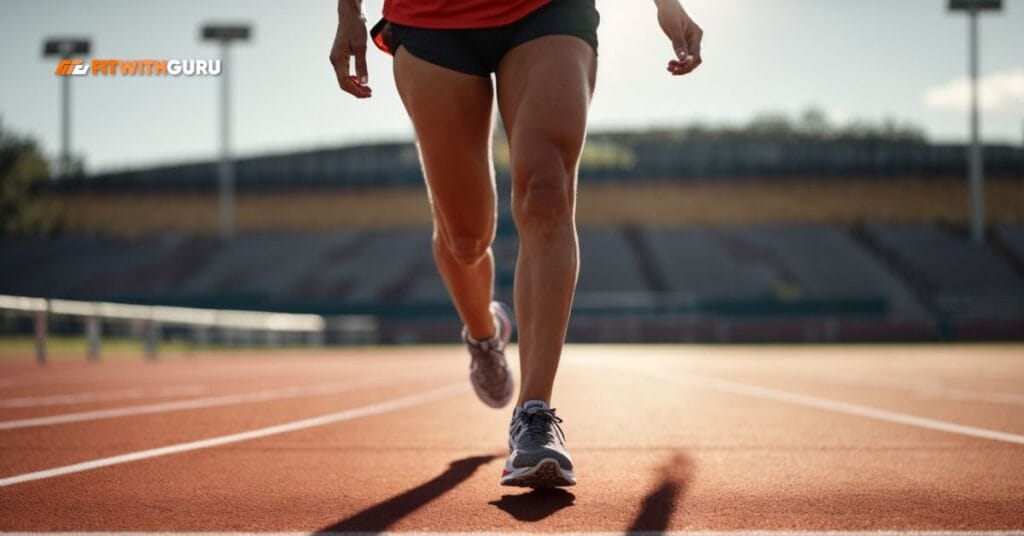Strength exercises for runners, though an essential part of a running fitness program, must be emphasized more among runners. Using calisthenics or bodyweight exercises significantly increases strength training for runners, develops muscular endurance, and reduces the chance of injury.
Here are six specific calisthenics exercises suitable for runners who want to increase their strength and endurance. These exercises are specially meant to help work out the muscles that are most important for running: the abdominal muscles, the legs, and the arms.
They are particularly beneficial for runners who use calisthenics to enhance their proper running techniques and stamina and even record an increased pace.
Why is Strength Training Important for Runners?
Strength training is not just a bonus; it is essential for every runner. Strength workouts should be frequent since they improve running and muscle strength.
If endurance is lacking, posture will be compromised, the stride will be off, and fatigue will eventually show in muscles and joints.
Strength training also recommends itself for muscle endurance. Through it, runners can run for long distances without feeling tired or changing their strides.
It stabilizes muscles in areas such as the knees and ankle region, which are familiar with injuries among runners because they are pertinent flex areas when running and consequently absorb shock.
Strength training for runners at home, when done alongside running, has the following benefits: it enhances running economy.
This means that a particular speed demands less energy. Improved muscle synergy and increased power result in better strides.
How Can Calisthenics Improve Running Strength?
Calisthenics is particularly suitable for running since its exercises are as functional for strength training as its mechanics. Push-ups, squats, and planks for the lower body are more fundamental for guaranteeing a stable platform and brute force.
Unlike typical weight-training programs, calisthenics relies on one’s weight to produce the pull and push, making it possible to do any exercise at any location without requiring any apparatus.
It also enhances muscular endurance, allowing runners to maintain proper form without feeling weary during long runs since calisthenics targets those stabilizing muscles necessary for posture.
It can help prevent, for example, runners’ knee, IT band syndrome, or Achilles tendinitis. These exercises cover all gigantic muscles in the human body and subsequently help improve running techniques.
Calisthenics also enhances flexibility and joint stability, which runners need during competition. When introduced into your training plan.
A strength training plan for runners will help you build robust strength that can easily complement your running routine, making you a better runner.
Exercise 1: Push-Ups
Push-ups are often among the most essential power bodyweight exercises, and they develop the upper body and core muscles. For runners, upper body muscle is essential in supporting their running posture.
Push-up exercises are especially beneficial if the runner is weary or encounters exhaustion during a long run or marathon. They press the chest, shoulders, and triceps and work the abdominal muscles.
Benefits for Runners:
Swings are beneficial for upper limb strength and essential in maintaining balance in running energies. An excellent upper body will ensure that the shoulders are well eased off to provide for proper thorax movements, which will impact the next step.
By including push-ups in your following regimen, you will develop enough strength to maintain the arms and shoulders muscles free and the chest expansive for ample oxygen intake.
Push-Up Variations:
- Standard Push-Up: Start with your hands shoulder-width apart in a plank stance. Push yourself back up after lowering your body until your chest almost touches the ground.
Building general strength training for runners is an excellent use for this traditional style.
- Incline Push-Up: Execute push-ups using a bench or step as support. This version is ideal for novices or those in the honing form because it lessens the strain on the upper body.
- Decline Push-Up: Keeping your hands on the ground, place your feet on a raised surface, such as a bench. This intensifies the workout and concentrates more on the shoulders and upper chest.
- Diamond Push-Up: Arrange your hands under your chest into a diamond pattern. This variation emphasizes the inner chest and triceps muscles.
How to Incorporate Push-Ups into Your Routine:
The best results are achieved from 3 sets of 10-15 push-ups 2-3 times a week. If you feel the regular repetitions are getting easy, try some variations, such as decline push-ups or diamond push-ups.
However, it is crucial to remember that observing good form is essential to prevent injury and to achieve supplementary fitness benefits.
Exercise 2: Pull-Ups
Pull-ups are an effective fitness exercise that trains the back, shoulders, and arms muscles, providing good resistance. For runners, back exercise also helps maintain good posture.
And they hardly feel tired when they are doing long runs. Strength training for runners also works on the abdomen and, most importantly, the middle section to provide much-needed balance.
Benefits for Runners:
Regular pull-ups can eliminate weak shoulder muscles that limit arm swinging and complement the upper back muscles responsible for maintaining St Rocket’s strength.
A good back should disprove the forward hiking trend among most runners, enhancing better posture.
Pull-Up Variations:
- Standard Pull-Up: Grip the bar with palms facing away and hands slightly wider than shoulder width. Pull your body up until your chin is over the bar, then lower yourself down with control.
This exercise is excellent for overall upper body strength.
- Chin-Up: Perform the pull-up with palms facing toward you. Strength training for runners emphasizes the biceps and can be more manageable for beginners.
- Assisted Pull-Up: Use a resistance band or an assisted pull-up machine to support part of your weight. This is useful for gradually building strength.
- Negative Pull-Up: Reach the peak of a pull-up by leaping or stepping up, then descend gradually. This concentrates on strengthening and controlling the eccentric phase of the movement.
How to Incorporate Pull-Ups into Your Routine:
If you are not doing pull-ups, establish the assisted pull-ups and do three sets of 5 to 8 pull-ups. This way, as you progress in your body strength, the frequency of the unassisted kind of pull-ups should also increase.
Perform pull-ups 2-3 days a week while giving enough space for the muscles to rest in between.
Exercise 3: Planks
Planks are among the best core exercises because they work on all the muscles along the body’s midsection.
A good core is crucial for runners because it helps maintain correct postural alignment during the run and prevents aches in the lower back. Strength training for runners is prevalent in long-distance running.
Benefits for Runners:
Muscular core strengthening strengthens the entire body and is critical for inspirational breathing and overall body mechanics for plank runners.
A firm core can also help deliver energy from the upper limb to the lower limb, providing better control over overall locomotion during running.
Plank Variations:
- Standard Plank: Begin in a forearm plank position with elbows directly under the shoulders. Engage your core throughout and maintain a straight body alignment from head to heels.
- Side Plank: Lie on your side and lift your hips off the ground, supporting your body on one forearm and the side of one foot. This variation targets the obliques, improving lateral stability.
- Plank with Leg Lift: In a standard plank position, lift one leg at a time without letting your hips drop. This adds an extra challenge to the core and glutes.
- Plank with Shoulder Tap: From a high plank position, tap your right shoulder with your left hand, then switch. Strength training for runners helps improve balance and core strength.
How to Incorporate Planks into Your Routine:
For each plank modification described above, sustain the position for 30-60 seconds, with 3-4 sets. Performing planks at least 3-4 days a week will help to establish and strengthen your core muscles.
Over time, adjust the time spent doing it or do more complex exercises such as the plank with leg pushouts or shoulder taps.

Exercise 4: Squats
Squats are lower-body compound exercises that focus mainly on the quadriceps, hamstrings, and glute muscles. Strong legs are beneficial for runners because they allow them to generate solid kicks and thereby improve their performance.
Squats are also helpful in enhancing the general stability of the lower body muscles, which play a significant role in form control, especially during extended runs.
Benefits for Runners:
Squats effectively create muscles in the lower body and help flex the hip and ankle joints. Strength training for runners smooths their gait and helps avoid problems like IT band syndrome or a runner’s knee.
Furthermore, in addition to the remedies obtained by applying the basic principle of toning all muscles, squats strengthen tendons and ligaments around the knees, improving support to the joint.
Squat Variations:
- Bodyweight Squat: Stand with feet shoulder-width apart. Maintain your knees behind your toes and lower your hips as you sit. Then, return to the standing position.
- Jump Squat: Perform a standard squat, but jump up as you reach the top position. This variant increases power and adds a cardiovascular component.
- Single-Leg Squat (Pistol Squat): Stand on one leg and lower your body as far as you can while keeping the other leg extended forward. This challenging variation improves balance and single-leg strength.
- Sumo Squat: Take a wider stance with your toes pointed out and perform a squat. This variation targets the inner thighs and glutes more intensely.
How to Incorporate Squats into Your Routine:
Ideally, three sets of 15-20 repetitions, 2-3 times a week. It is best to begin with the bodyweight exercise before moving to the more complicated ones.
It is essential to pay attention to form to prevent injury to the knee joint and get the most out of the exercise.
Exercise 5: Lunges
Squats are sensational for strengthening the quadriceps, hamstrings, and hips, and they are focused on a runner’s stride action. Strength training for runners also enhances physical balance and coordination, which are crucial for body posture and agility in complicated terrain.
Benefits for Runners:
Lunges help correct muscle imbalances between the left and right legs, thus enhancing good running form. They also help strengthen and increase the hip joint’s flexibility, yielding increased flexibility within the hip area.
And the power with which a runner is likely to hit the ground, reducing the chances of injuries. Lunges also benefit from the core, the solid base that helps keep the body’s upper part steady.
Lunge Variations:
- Forward Lunge: Step forward with one leg and lower your hips until both knees are bent at a 90-degree angle. Return to the starting position and repeat on the other side.
- Walking Lunge: Perform a forward lunge but continue stepping forward with the opposite leg. This variation adds a dynamic element, improving balance and coordination.
- Reverse Lunge: Step back into a lunge position. This is easier on the knees and can help improve control and stability.
- Lateral Lunge: Step to the side and lower your hips, keeping one leg straight while bending the other. This variation targets the inner thighs and improves lateral movement.
How to Incorporate Lunges into Your Routine:
Swallow 3 sets of 10-12 lunges to a single leg thrice weekly. As you progress, adding variations or weight can make the exercise harder. Ensure that the back is straight and the abdominal muscles are used during the movement.
Exercise 6: Burpees
Burpees are an exercise that targets muscles on the upper part of the body, stomach, and legs apart from the heart part since they are aerobics.
Both attack several muscles in the arms, chest, core, and legs, making the exercise important in building endurance and explosive power.
Benefits for Runners:
Burpees help build cardiovascular endurance, and strength training for runners is essential for marathon runners who have to pace themselves.
Burpees also develop explosive strength in the legs, which is very beneficial for sprinting and running uphill. Further, burpees affect the abdominal wall, stabilizing the spine and improving posture.
Burpee Variations:
- Standard Burpee: Begin standing, drop into a squat, kick your feet back into a plank, perform a push-up, jump your feet back to your hands, and explosively jump up. This is a great way to build strength and cardiovascular fitness.
- Half Burpee: Perform the burpee without the push-up or jump. This lower-intensity version is suitable for beginners or as a warm-up.
- Burpee with Tuck Jump: Add a tuck jump at the top of the burpee for an added plyometric challenge, increasing the difficulty and cardiovascular demand.
- Burpee with Push-Up: To increase the strength component, incorporate a push-up at the bottom of the movement, focusing more on the upper body.
How to Incorporate Burpees into Your Routine:
It is recommended that three sets of 10-15 repetitions be performed at least 2-3 times a week. Therefore, burpees can be incorporated alongside HIIT resistance training or as an exercise commonly used to enhance endurance and strength.
The intensity and number of repetitions should be chosen depending on the person’s fitness level.

People Also Ask
Can strength training help running?
Strength training can help improve running by increasing muscle strength, endurance, and stability, enhancing speed, reducing injury risk, and improving overall performance.
What is strength training for runners?
Strength training for runners is performing exercises on the muscles that form the core, legs, and upper body to make the runner more muscular, stable, and efficient. They include helping to improve performance and discouraging instances of getting an injury.
Can strength training help you lose weight?
Strength training is good for weight loss as it increases the amount of muscle tissue that will burn calories even without actual exercise. It also aids in weight loss and contributes to body composition and makeup.
Does strength training prevent running injuries?
Yes, strength training may be suitable for preventing common running injuries. When your muscles are more robust and your joints more stable, there will be less stress on your joints and, therefore, a drastically lowered chance of contracting these illnesses.
Conclusion
That is why using calisthenics while strength training can positively impact your running. Strength training for runners falls under bodyweight training. It is crucial to strengthen muscles and build endurance and stability without necessarily using all the equipment.
Hence, by exercising the six types of exercises—push-ups, pull-ups, planks, squats, lunges, and burpees—one can develop the muscular strength and coordination to enhance one’s running form, reduce the chances of developing injuries, and run to whatever goal one has set.

